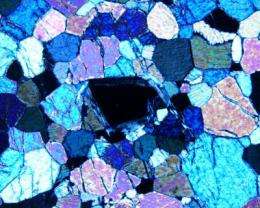Prussian blue linked to the origin of life

A team of researchers from the Astrobiology Centre (INTA-CSIC) has shown that hydrogen cyanide, urea and other substances considered essential to the formation of the most basic biological molecules can be obtained from the salt Prussian blue. In order to carry out this study, published in the journal Chemistry & Biodiversity, the scientists recreated the chemical conditions of the early Earth.
"We have shown that when Prussian blue is dissolved in ammoniac solutions it produces hydrogen cyanide, a substance that could have played a fundamental role in the creation of the first bio-organic molecules, as well as other precursors to the origin of life, such as urea, dimethylhydantoin and lactic acid", Marta Ruiz Bermejo, lead author of the study and a researcher at the Astrobiology Centre (CSIC-INTA), tells SINC.
Urea is considered to be an important reagent in synthesising pyrimidines (the derivatives of which form part of the nucleic acids DNA and RNA), and it has been suggested that hydantoins could be the precursors of peptides and amino acids (the components of proteins), while lactic acid is also of biological interest because, along with malic acid, it can play a role in electron donor-recipient systems.
The researcher and her team have proved that these and other compounds originate from the cyanide liberated by the salt Prussian blue (the name of which refers to the dye used in the uniforms of the Prussian Army) when it is subjected for several days to conditions of pH12 and relatively high temperatures (70-150ºC) in a damp, oxygen-free ammoniac environment, similar to early conditions on Earth. The results of the study have been published recently in the journal Chemistry & Biodiversity.
"In addition, when Prussian blue decomposes in this ammoniac, anoxic environment, this complex salt, called iron (III) hexacyanoferrate (II), also turns out to be an excellent precursor of hematite, the most stable and commonly found form of iron (III) oxide on the surface of the Earth", explains Ruiz Bermejo.
Hematite is related to the so-called Banded Iron Formations (BIF), the biological or geological origin of which is the source of intense debate among scientists. The oldest of these formations, more than two billion years old, have been found in Australia.
The researchers have confirmed in other studies that Prussian blue can be obtained in prebiotic conditions (from iron ions in methane atmosphere conditions with electrical discharges). The synthesis of this salt and its subsequent transformation into hematite offers an alternative model to explain the formation of the banded iron in abiotic conditions in the absence of oxygen.
Ruiz Bermejo concludes that Prussian blue "could act as a carbon concentrator in the prebiotic hydrosphere, and that its wet decomposition in anoxic conditions could liberate hydrogen cyanide and cyanogen, with the subsequent formation of organic molecules and iron oxides".
More information: Marta Ruiz Bermejo, Celia Rogero, César Menor Salván, Susana Osuna Esteban, José Ángel Martín-Gago y Sabino Veintemillas Verdaguer. "Thermal wet decomposition of Prussian Blue: Implications for Prebiotic Chemistry". CHEMISTRY & BIODIVERSITY 6 (9): 1309-1322, 2009.
Source: FECYT - Spanish Foundation for Science and Technology

















